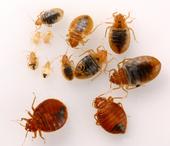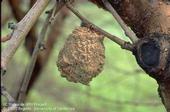- Author: Tunyalee A. Martin
![Coyote in residential neighborhood. [T. Boswell]](https://ucanr.edu/blogs/UCIPMurbanpests/blogfiles/34596small.jpg)
Wildlife and people have been in the news lately. Perhaps you've heard of coyotes wandering in your neighborhood. You might have also read about how you shouldn't feed wildlife. Did you know they are connected? It's a problem when people feed coyotes either intentionally or unintentionally through uncovered garbage and outdoor pet food. Available food may encourage coyotes to associate closely with humans and to lose their natural fear of us. These interactions will be discussed during a special symposium on urban coyotes at the 27th...
- Author: Andrew Mason Sutherland

[From the December 2015 issue of the UC IPM Green Bulletin]
Survey of professional bed bug management in multi-unit housing
Bed bug management is especially challenging in multi-unit housing (MUH) situations such as public and low-income apartment buildings. In these environments, high resident turnover, lack of resources, ease of bed bug dispersal, and communication barriers may all contribute to chronic infestations.
Researchers and policymakers recognize the need to address this challenging...
- Author: Siavash Taravati
![Brown marmorated stink bug adult (top) and nymph (bottom). [A. Ausmus]](https://ucanr.edu/blogs/UCIPMurbanpests/blogfiles/34180small.jpg)
Brown marmorated stink bug (BMSB), Halyomorpha halys, is an invasive pest native to East Asia (China, Japan, Korea, Taiwan) which was first sighted in the United States in 1996 in Allentown, PA, and reached California in 2006 (Pasadena and San Marino). It is currently established in several regions in California including Los Angeles, Santa Clara, Stanislaus, San Joaquin, Sacramento, Yolo, Sutter, Butte, and Siskiyou counties.
Since its introduction, BMSB has spread to 38 states on the East and West Coasts, where it has caused damage to fruits, vegetables, and ornamental plants. BMSB is also a significant nuisance pest for residents and businesses, since it may invade structures in large numbers for overwintering during...

Did you make a resolution to be healthier in 2016? If so, why not add keeping your landscape healthy to your resolution? UC IPM has a new resource that can help.
The Seasonal Landscape IPM Checklist or SLIC is a regional decision-making tool that can help you keep your landscape healthy by preventing pests and plant problems. It was designed to help landscape professionals and home gardeners know which activities to do to prevent, monitor, or manage pests each month. Monthly lists can be viewed online or printed as a PDF and you can carry it with you to ‘check off' activities as you work outside.
The newest feature of the tool...
- Author: Lisa A Blecker
![Pesticide application. [J.K. Clark]](https://ucanr.edu/blogs/UCIPMurbanpests/blogfiles/34058small.jpg)
[From the December 2015 issue of the UC IPM Green Bulletin]
On August 5, 2015, EPA released a proposal to revise the standards for both commercial and private certified pesticide applicators. In California this rule would affect anyone with an applicator certification or license through the Department of Pesticide Regulation (DPR), the Department of Public Health (DPH), the Structural Pest Control Board (SPCB), or the County Agricultural Commissioner's office (CAC).
Affected licenses include:
- Qualified Applicator Certificate...


